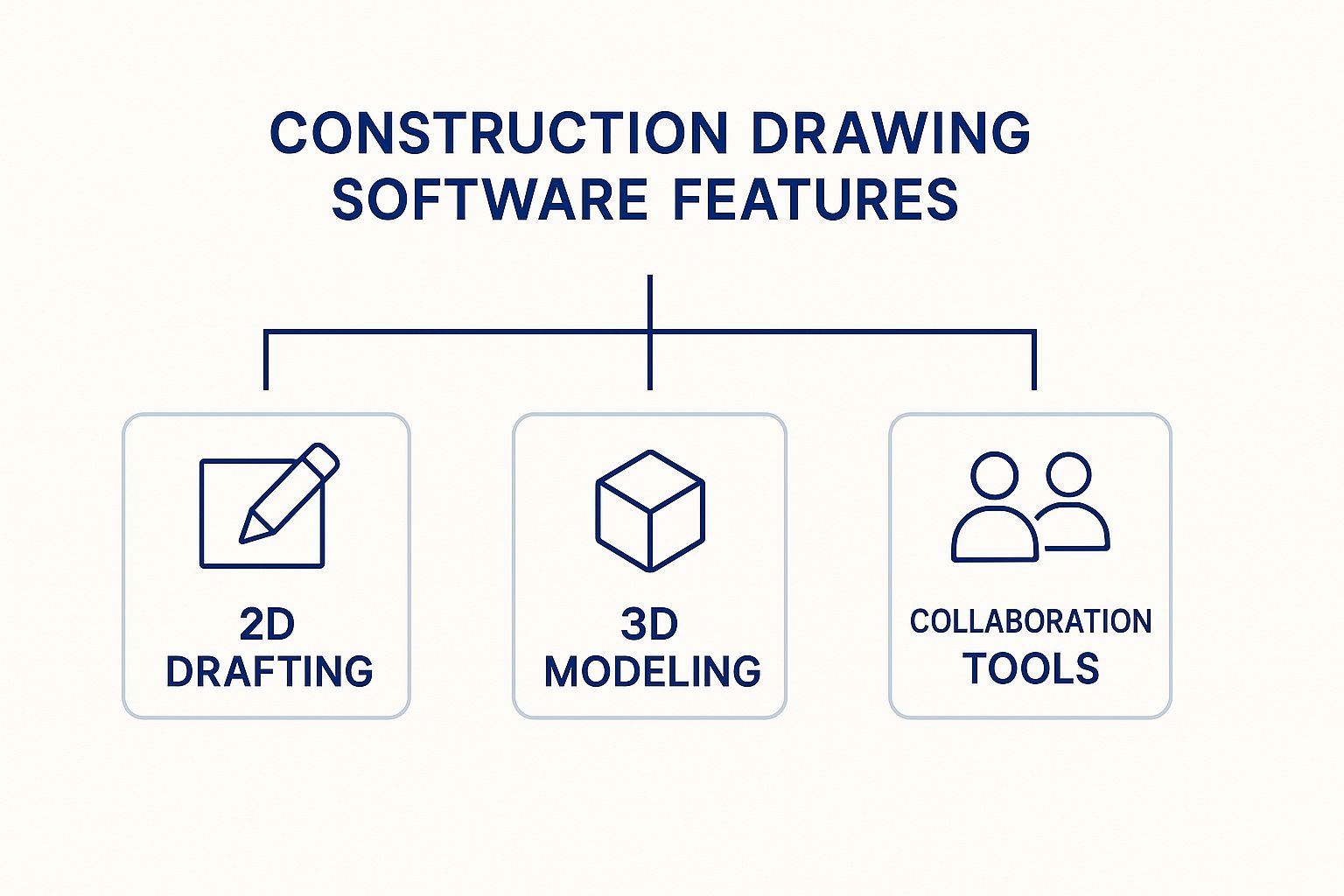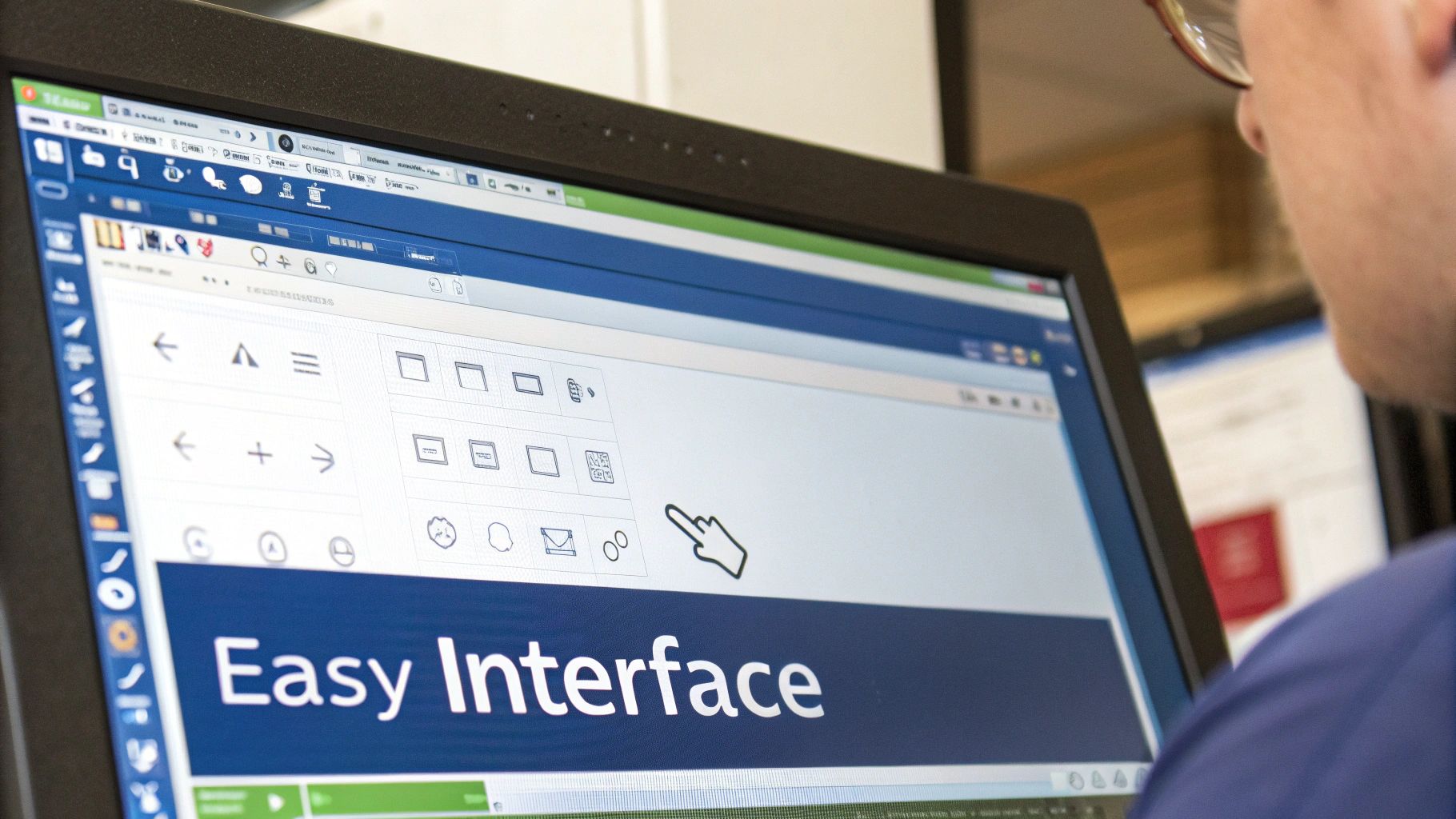For business leaders overseeing major capital projects in Texas, traditional blueprints are a relic. They are a static map in a world demanding real-time data. Modern construction drawing software functions as an interactive, data-rich GPS for your entire project, accessible to teams in a Houston corporate office and on a remote Permian Basin job site simultaneously. This guide provides actionable insights for assessing and implementing this technology to mitigate operational risks and enhance project outcomes.
Understanding Construction Drawing Software
At its core, this software is the central command for creating, managing, and sharing architectural and engineering plans. It transforms traditional 2D lines into intelligent 3D models containing critical data, from the tensile strength of a specific steel beam to the maintenance schedule for an HVAC system. For decision-makers in Texas's Energy, Manufacturing, and Logistics sectors, mastering this technology is critical for ensuring precision and foresight. The global construction design software market reached approximately USD 10.2 billion in 2024, with its rapid growth driven by the need for enhanced collaboration and risk mitigation in complex industrial projects.
The Evolution From CAD To BIM
The shift from simple digital drafting to intelligent modeling represents a fundamental change in project management. While Computer-Aided Design (CAD) digitized 2D plans, the industry has advanced to a more powerful methodology.
Building Information Modeling (BIM) is not merely a 3D model; it is a data-rich digital twin of a physical asset. This allows stakeholders to visualize, analyze, and manage every component of a project's lifecycle before construction begins.
This digital-first approach establishes a single source of truth, significantly reducing the costly errors and miscommunications common when teams rely on disparate, outdated paper plans. It is a critical step forward, essential for sophisticated operational risk management. This guide on Building Information Modeling (BIM) offers a detailed overview of the technology. For the complex petrochemical plants, manufacturing facilities, and logistics hubs integral to the Texas economy, this model-based method is essential for executing projects that are both resilient and efficient.
Key Capabilities Driving Project Success
To move beyond technical jargon, decision-makers must understand which specific software capabilities deliver tangible results. Modern construction drawing platforms are built around core features that are essential for keeping complex industrial projects in Texas on schedule, within budget, and compliant with regulatory standards. These capabilities build upon each other, progressing from basic drawings to powerful, data-driven insights that prevent costly operational disruptions.

The following table breaks down the essential functions of modern construction software and their direct business benefits.
Essential Capabilities of Modern Construction Software
| Feature | Description | Primary Business Benefit |
|---|---|---|
| 2D Drafting | The foundation for creating traditional floor plans, elevations, and schematics. The digital equivalent of classic blueprints. | Provides clear, standardized plans for permitting, basic layout, and contractual documentation. |
| 3D Modeling | Creates a three-dimensional, visual representation of the project, allowing stakeholders to see how components will fit together. | Improves spatial understanding and helps identify obvious design flaws before construction begins. |
| Building Information Modeling (BIM) | Infuses a 3D model with layers of data (materials, costs, specs, etc.), creating a "digital twin" of the facility. | Enables deep analysis, accurate cost estimation, and lifecycle management of the asset. |
| Clash Detection | An automated BIM function that identifies where different systems (e.g., electrical, plumbing, structural) conflict or intersect. | Prevents expensive on-site rework and delays by solving design conflicts digitally, saving significant capital. |
| Cloud-Based Collaboration | A central, cloud-hosted model accessible to all team members, ensuring everyone works from the same version. | Eliminates version control errors and communication gaps between architects, engineers, and field crews. |
| Version Control & History | Automatically tracks and saves every change made to the design, creating a complete, auditable project history. | Provides accountability, simplifies issue resolution, and protects against liability claims. |
These features work in concert to create a single source of truth, a non-negotiable requirement for managing large-scale industrial operations and mitigating risk.
From Blueprints to Digital Twins
While 2D drafting remains essential for clear floor plans and schematics, 3D modeling provides the critical spatial awareness needed for large-scale energy or manufacturing facilities. The true strategic advantage, however, lies in Building Information Modeling (BIM). BIM transforms a static 3D model into a dynamic digital twin of your asset. Every component, from a structural I-beam to a pipeline valve, is embedded with data—material specifications, supplier information, cost, and maintenance schedules.
A core BIM function is clash detection. The software automatically scans the design and flags conflicts, such as an HVAC duct intersecting with a primary support beam. Identifying a single clash during the design phase can prevent tens of thousands of dollars in rework and schedule-killing delays.
This shift toward intelligent digital workflows explains the market’s significant growth. Forecasts indicate the global construction and design software market will exceed USD 11.75 billion by 2029, underscoring the value these tools deliver.
For teams distributed across Texas—from a fabrication shop in Houston to a project site in the Permian Basin—several features are indispensable:
- Cloud-Based Collaboration: Ensures architects, engineers, and contractors access the same up-to-date model, eliminating version control issues.
- Version Control: Creates a clear audit trail by tracking every change, which is crucial for accountability and issue resolution.
Integrating these tools into your workflow can significantly reduce errors and improve project timelines. Our resource on strategies for improving operational efficiency provides further detail on how digital tools create more resilient operations.
The Strategic Edge for Texas Industrial Projects

For Texas's industrial sectors, construction drawing software is a core strategic asset, not just a design utility. It delivers tangible improvements in efficiency, risk management, and regulatory compliance for the large-scale energy, manufacturing, and logistics projects that anchor the state's economy. The most immediate financial benefit is the reduction of material waste. Digital precision ensures that materials like steel, concrete, and piping are calculated with exacting accuracy, virtually eliminating over-ordering and costly scrap on multi-million dollar projects.
Enhancing Collaboration and Project Timelines
Modern platforms dismantle the communication barriers that traditionally exist between architects, engineers, and contractors. By working from a single, cloud-based model, teams can identify and resolve conflicts in near real-time. This dynamic prevents the miscommunications that once led to weeks of delays and expensive rework, addressing them in the digital phase before they manifest on-site.
This unified model is the foundation of proactive risk management. By running construction simulations and identifying clashes before work begins, you prevent the costly rework and safety incidents that can halt a project.
This digital-first approach also strengthens operational resilience. Integrating detailed site plans with environmental data is a vital step in critical infrastructure protection. It enables the design and construction of facilities prepared for Texas’s unique and often extreme weather challenges, from hurricanes along the Gulf Coast to extreme heat statewide.
Navigating Regulatory Complexity
This software is also essential for navigating the complex web of state and federal regulations. It generates the detailed documentation required to secure permits and demonstrate compliance with Texas building codes and stringent industry standards, such as those in the petrochemical sector. What was once a daunting administrative burden becomes a manageable, data-driven workflow, ensuring projects proceed on schedule and avoid costly compliance penalties.
Disclaimer: ClimateRiskNow does not sell insurance or financial products. The information provided is for educational purposes only and should not be interpreted as financial advice or an insurance recommendation.
Integrating Digital Plans with Operational Risk Management

Effective construction drawing software is more than a design tool; it is a cornerstone of corporate operational resilience. The detailed data within these digital models becomes a powerful asset when integrated with broader risk management strategies, transforming abstract threats like extreme weather into tangible design challenges that can be solved proactively.
For example, a detailed 3D site model for a new coastal petrochemical facility can be overlaid with NOAA storm surge projections or FEMA floodplain maps. This integration immediately reveals specific vulnerabilities, allowing architects and engineers to make data-informed design adjustments—such as raising critical equipment elevations, specifying flood-resistant materials, or engineering enhanced drainage systems—long before construction begins. This proactive approach is fundamental to building a resilient business. To learn more about this framework, our guide on what operational risk management is details how to integrate these data-driven insights.
Simulating Threats to Harden Assets
The true power of this software lies in its ability to shift from reactive problem-solving to proactive, resilient design. By combining asset-specific data with environmental risk factors, companies can run simulations to test a facility’s durability against specific threats prevalent in Texas.
- Wind Load Analysis: Simulate the impact of hurricane-force winds on a proposed structure to identify and reinforce weak points in roofing, cladding, or support systems before they are built.
- Flood Mitigation Planning: Use elevation data within the model to plan site logistics, equipment staging areas, and access routes that remain viable during a 100-year flood event.
- Extreme Heat Impact: Model how intense heat will affect material expansion or increase loads on HVAC systems for critical control rooms and processing areas within a manufacturing plant.
By visualizing climate impacts directly on project plans, you move from assuming a facility is resilient to verifying it through data. This process provides the quantitative evidence needed to justify investments in more robust designs that protect physical assets and ensure business continuity.
Disclaimer: ClimateRiskNow does not sell insurance or financial products. The information provided is for educational purposes only and should not be interpreted as financial advice or an insurance recommendation.
How to Select the Right Software for Your Company
Selecting the appropriate construction drawing software is a significant decision that impacts not only design capabilities but also project efficiency and the long-term resilience of your Texas-based assets. A structured evaluation process is key. The first step is a clear assessment of your company's primary functions. Does your firm primarily handle straightforward 2D drafting, or does it manage complex industrial facilities in the Energy and Manufacturing sectors that require a full-scale Building Information Modeling (BIM) platform? Answering this question prevents over-investing in unused features or under-equipping your team for critical project demands.
Define Your Core Requirements
Interoperability is a critical requirement. The selected software must integrate seamlessly with the systems used by your network of engineers, contractors, and partners across Texas. A platform that creates data silos will inevitably lead to project delays and costly rework. Just as important is the user experience. The most powerful tool is ineffective if your team finds it too complex to adopt.
- User-Friendliness: Is the interface intuitive, or does it require a specialist for basic tasks?
- Training and Support: Does the vendor provide comprehensive training and reliable technical support to ensure effective adoption?
- Scalability: Will the software scale with your company's growth, or will it require replacement in a few years?
The US construction software market is projected to reach USD 2.41 billion by 2034, driven by advancements in AI and data analytics. Choosing a scalable platform ensures you can leverage these capabilities as they become available. You can find detailed market growth insights here.
During evaluation, consider specialized needs. For high-stakes client presentations, exploring options in software for architectural rendering may be critical. This selection process should align with your broader risk management strategy. Utilizing robust climate risk assessment tools ensures your designs account for real-world environmental threats in your operational regions.
Disclaimer: ClimateRiskNow provides this educational framework to empower your decision-making. We do not sell insurance or financial products and do not endorse any specific software providers.
Frequently Asked Questions About Construction Drawing Software
When business leaders evaluate new technology, several key questions consistently arise. For construction drawing software, the focus should be on practical application and tangible business outcomes. A sound investment begins with clear, data-driven answers.
Here are responses to common questions from executives in Texas industries.
What’s the Real Difference Between CAD and BIM?
Computer-Aided Design (CAD) is a powerful digital drafting tool, excellent for creating precise 2D drawings and basic 3D models. It is the modern equivalent of traditional blueprints and is fundamentally about representing geometry. Building Information Modeling (BIM), in contrast, is a process centered on creating an intelligent digital prototype of a facility. A BIM model is not just a 3D image; it is a relational database. Each element contains layers of data, such as material specifications, supplier costs, and installation schedules. While CAD is used to draw the building, BIM is the building in a digital format, enabling deep analysis and collaboration that is otherwise impossible.
Can We Use This Software on Our Existing Facilities?
Yes. One of the most valuable applications is for retrofits, renovations, and expansions of existing industrial facilities. Using technologies like 3D laser scanning, an exceptionally accurate "as-built" digital model of a current structure can be created.
This allows engineering and design teams to plan modifications with surgical precision. It enables them to identify potential clashes with existing infrastructure, such as legacy piping or machinery, before work begins. This is critical for manufacturing plants and distribution centers where operational downtime must be minimized.
What’s a Realistic Learning Curve for Our Team?
The learning curve depends on the chosen software and your team’s existing technical proficiency. A straightforward 2D CAD program can often be adopted quickly with minimal disruption. A full-scale BIM platform, however, represents a significant operational shift. It is not just about learning new software but adopting new workflows. When evaluating vendors, scrutinize their training and support offerings. Many successful firms mitigate transition risks by implementing the software on a pilot project first. This approach builds in-house expertise and allows for a phased, manageable transition across the organization.
ClimateRiskNow provides the strategic insights Texas businesses need to turn complex weather data into a competitive advantage. Equip your team with the actionable intelligence required to protect your assets and ensure operational continuity.

